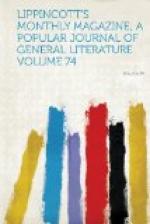It is difficult to understand the crass stupidity which blocked up exquisite Norman windows, covered carved capitals with a thick coat of cement, closed many of the arches with wooden partitions, planted a cumbrous pulpit and reading-desk immediately under the dome, and hid the noble groined ceiling behind a shell of flat, whitewashed boarding. In the course of these repairs much of the marble-work was found to require renewal, for replacing which some old quarries in the Isle of Purbeck, unworked for generations, were reopened.
On the pavement, immediately under the Round, are several marble effigies of mail-clad knights,—“Associates of the Temple.” Those that have been identified represent Geoffry de Magnaville, Earl of Essex, one of the barons who fought against King Stephen; another, having clean-cut features and clad in chain-armor, commemorates William Marshall, who was Protector during the reign of Henry III,; and by his side rests his son, a leader of the Barons in their memorable struggle against King John. The effigy of Gilbert Marshall, third son of the Protector, reposes near the western door-way, and hard by is the figure of a warrior in the act of prayer, supposed to be intended for Robert, Lord of Ros. Five or six other figures, some of remarkable beauty, and all in good preservation, two of heroic stature, are unidentified.
Service is held daily in the Temple Church, and admission is practically free. On Sunday mornings, however, the introduction of a bencher is requisite to secure admittance. The music is of the best of its kind, and the organ, though of great age, is renowned as one of the purest-and sweetest-toned instruments in London.
No account of the Temple would be complete without some mention of its many curious sundials. Each garden possesses a plain pillar-dial. There is one in Temple Lane with the motto, “Pereunt et imputantur,” and “Vestigia nulla retrorsum” appears on another in Essex Court. In Pump Court, high up on the front of a house is a large, rectangular dial, with gilt figures and stile, bearing the inscription, “Shadows we are and like shadows depart.” Over the dial is the traditional Temple lamb bearing a cross.[A] In Brick Court there is a dial with the apt legend, “Time and tide tarry for no man.” In the year 1828 an ancient building on Inner Temple Terrace was demolished, and with it a sundial bearing the strange but not inappropriate inscription, “Begone about your business.” The story runs that, many years before, a crusty old bencher had promised the dial-maker to provide a motto for the then new dial. The messenger, however, arrived at an inopportune time, received the above curt dismissal in answer to his request, and conveyed it to his master as the legend to be engraved.
[Footnote A: The devices of the Middle and Inner Temple are a lamb and a horse respectively, and they may be frequently seen blazoned on window and wall. An irreverent wit once scrawled these lines on the Temple gate:




